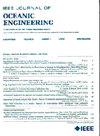卫星SAR图像中移动舰船的自适应重聚焦链
IF 5.3
2区 工程技术
Q1 ENGINEERING, CIVIL
引用次数: 0
摘要
针对卫星合成孔径雷达(SAR)图像中舰船运动目标的不同运动类型,提出了一种舰船运动图像的自适应再聚焦方案。为了确定舰船的运动类型,在ISAR信号逆模型的基础上,利用时频联合学习模型对主散射体的相位信号进行分析。然后,使用适当的基于isar的重新聚焦算法来生成考虑船舶运动的良好聚焦图像。自适应重聚焦概念的设计使我们能够选择合适的算法来获取精确的舰船目标散射机制。此外,针对舰船复杂的三维运动造成的离焦问题,设计了一种基于压缩感知的有效重构策略。这是一个不同于传统的最优时间窗的概念,它处理船舶目标的复杂运动,并产生一个良好的聚焦图像,保留了原船舶图像的空间分辨率。在模拟和真实SAR图像的实验中,与传统方法相比,该方法对各种舰船目标显示了可靠的重聚焦结果。本文章由计算机程序翻译,如有差异,请以英文原文为准。
Adaptive Refocusing Chain for Moving Ships in Satellite SAR Images
In this study, an adaptive refocusing scheme for moving ships in satellite synthetic aperture radar (SAR) images is proposed to cope with various types of motions of ship targets. To decide the type of ship's motion, the phase signals of principal scatterers are analyzed based on the inverse SAR (ISAR) signal model with the help of a joint time–frequency transform and deep learning model. Then, proper ISAR-based refocusing algorithms are used to generate a well-focused image considering the ship's motion. The design of the adaptive refocusing concept enables us to select appropriate algorithms to retrieve the exact scattering mechanisms of ship targets. In addition, to cope with defocusing due to the complex 3-D motion of the ship, an efficient reconstruction strategy based on compressive sensing is devised. It is a concept different from conventional optimal time windowing, which deals with the complex motion of the ship target, and it yields a well-focused image that retains the spatial resolution of the original ship image. In experiments using simulated and real SAR images, the proposed method shows reliable refocusing results for various ship targets compared to traditional methods.
求助全文
通过发布文献求助,成功后即可免费获取论文全文。
去求助
来源期刊

IEEE Journal of Oceanic Engineering
工程技术-工程:大洋
CiteScore
9.60
自引率
12.20%
发文量
86
审稿时长
12 months
期刊介绍:
The IEEE Journal of Oceanic Engineering (ISSN 0364-9059) is the online-only quarterly publication of the IEEE Oceanic Engineering Society (IEEE OES). The scope of the Journal is the field of interest of the IEEE OES, which encompasses all aspects of science, engineering, and technology that address research, development, and operations pertaining to all bodies of water. This includes the creation of new capabilities and technologies from concept design through prototypes, testing, and operational systems to sense, explore, understand, develop, use, and responsibly manage natural resources.
 求助内容:
求助内容: 应助结果提醒方式:
应助结果提醒方式:


